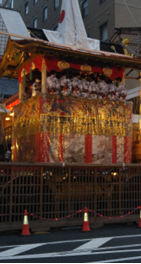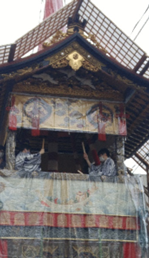Is Gion Bayashi communicating with the universe? !!
Yoshie Doi
 |
 |
 |
July 16, 2022 Gion Matsuri Yoiyama Performer in the Hoko
About 10 years ago, I had lunch at a cafe next to the Eiffel Tower in Paris. At that time, a person from the Ministry of Foreign Affairs, who loves Kyoto in her studies, said, “Gion Bayashi is Insignificant.” The shocking words made me very shocked.
“The metallic sound of conchikitin has been used to communicate with space since ancient times,” I said.
I myself have never felt that Gion Bayashi was insignificant. However, when we think about it, unlike the Awa Odori and brave festivals in other prefectures, the festivals in Kyoto are quiet.
At that time, I remembered the content of the lecture, “Since ancient times, metallic sounds have been used to communicate with the universe.” I heard that from a sound researcher and remembered it then in Paris.
I don’t know if the frequency of the metallic sound is related to the origin of the universe, but is it a frequency that resonates with the frequency of the universe, makes God happy, and is comfortable for the human body? For me, who grew up listening to this conchikitin every year for many years, it is also the sound bring us having peace of mind that summer has come.
The Gion Festival is a Gion Festival only if there are two things, the Yamahoko parade and the Mikoshi moving. It is said that the Mikoshi moving started around the end of the Heian period, and the Yamaboko parade started around the end of the Kamakura period. The Yamahoko parade is held in the morning, and the Mikoshi moving is held in the evening this style is still the same.
The Mikoshi moving is a powerful voice, “Whitto, whitto-“, and it becomes dense and parades while swinging the Mikoshi up and down. The Gion Festival consists of a loud prayer to dispel the plague and a Conchikitin that reaches the universe.
Until the Meiji era, it was held on June 7th and June 14th of the lunar calendar (July 17th and July 24th of the new history). From the Kamakura period to the 30’s of the Showa eras, there were two Yamahoko parade, a pre-festival and a post-festival. (Unified on July 17, 1966)
The word “pre-festival” has been used since the Edo period, and until then it was read as “Nanokayamahoko”. Also, the word Gion Matsuri has been used since the Edo period. Before that, only the words Gion-e and Gion-goryoe appeared in the literature. In the Heian period, it was called Gion-goryo-e. I will write about why it was called the Goryo-e in the next blog.
It is a festival to pray for the peace of the town by going around each town to pray for the extinction of the plague. It’s a festival that expresses the deep culture of Kyoto, where both static and dynamic are combined.
The end of document
